Some guitarists are loners. They prefer to play solo or to be their band’s only guitarist—and that’s cool. But not all guitarists think that way. Some need a partner in crime and prefer playing in a two-guitar band. Some guitarists want even more, and their bands boast three guitars. Think Lynyrd Skynyrd. And sometimes—like at celebrity jams and tributes—even more guitarists crowd the stage.
But how about 11?
Noted composer, percussionist, and world music pioneer Adam Rudolph thinks that’s okay. His Go: Organic Guitar Orchestra, an all-guitar offshoot of his innovative Go: Organic Orchestra is an ensemble comprising only guitars—11, actually. And it’s not just any guitarists. Rudolph’s ensemble features the cream of New York’s avant-garde and includes Rez Abbasi, Nels Cline, Liberty Ellman, David Gilmore, Miles Okazaki, Marvin Sewell, Damon Banks, Marco Cappelli, Jerome Harris, Joel Harrison, and Kenny Wessel.
Rudolph, a Chicago native, made his name playing percussion with musicians like trumpeter Don Cherry and saxophonist Fred Anderson. A student of world music, he traveled the globe and immersed himself in local styles and cultures. “It was more than studying,” Rudolph says about his year in Ghana in West Africa. “It was going around to a lot of different ceremonies and being around the whole life that gave root to the music. That was really what was so interesting for me.” In 1988, he began a long association with multi-instrumentalist Yusef Lateef, which lasted until Lateef’s death in 2013. Rudolph has worked with myriad other artists as well. His projects and collaborations include duets, small groups, and large ensembles with an impressive roster of A-list musicians, and span everything from free improvisation to through-composed works.
Rudolph started the first incarnation of his orchestra in 2001. “I started the Go: Organic Orchestra because of my great good fortune to be mentored by and to learn from the great masters. I learned about creative attitude and this idea of process. If you can think of your own creative process—how to go about things—you can come up with your own music. That’s what I learned from my mentors, and that is what I try to share now. Since 2000, I felt it was my turn to be sharing with as many musicians as possible.”
The Go: Organic concept employs Rudolph’s ideas about polyrhythm, rhythmic cycles, harmony, and sonic language in a large improvisatory ensemble. The orchestra exists in various line-ups and includes regular East and West Coast working groups, a string ensemble, and, starting in 2014, the all-guitar orchestra. “These 11 guitarists are really different players from each other,” he says. “They all have their own voice, their own sound, their own approach. I want their inner voices to shine through and to challenge them in some way to reach beyond themselves.” The Go: Organic Guitar Orchestra recently released Turning Towards the Light, which was recorded on the winter solstice in 2014. The ensemble toured the East Coast last fall and was featured in New York City at the Stone in late May as part of Rudolph’s weeklong residency there.
What does the Go: Organic Guitar Orchestra sound like? Probably not how you’d expect. Although the music is rhythmically complex, the lack of percussion takes off some of the edge. Imagine a more sophisticated version of Discipline-era King Crimson—simple ostinato figures, contrapuntal responses, and a mellow, bubbling vibe percolating within the polyrhythmic mush. The tonal tapestry is rich as well and often very un-guitar-like. For example, a few of the guitarists use heavy, saturated tones tempered with volume swells, which resemble violin. That unique timbre contributes to an overall ensemble sound that gives off a simultaneously traditional yet futuristic vibe.
We spoke with Rudolph about the magic of working with guitarists, his unique insights into the universal nature of music, and the raw power of overseeing a project that features over 100 effects pedals. We also talked with Go: Organic Guitar Orchestra participants Nels Cline and Damon Banks to get an insider’s look at playing in such a unique setting. (See sidebars.)
Describe the genesis of the Go: Organic Guitar Orchestra.
Well, just to give a little background about the Go: Organic Orchestra in general, I’ve always been very interested in process. I developed a process of putting the music together with the Go: Organic Orchestra that is it’s own prototype. The way the process works—the relationship between the performers, the score elements, and my own conducting technique—can be adapted to any kind of ensemble. I have two guitarists who are in my New York-based Go: Organic Orchestra, but a lot of other guitarists in the area expressed interest. I thought it would be so interesting to have an all-guitar orchestra because, first of all, guitarists can handle a lot of the rhythms I use in my music. I use a concept of rhythm I call “Ostinatos of Circularity,” and I felt they could adapt to that well because of the nature of guitar. I also felt that—with the kinds of foot pedals and processing that so many guitar players now are adept at—we could really have a huge, fascinating, and prototypical sounding orchestral palette. And thirdly, a lot of the interval material that I use in the orchestra would be interesting for guitar players to interpret both melodically and harmonically.
Once the idea came to mind it seemed inevitable. When I put the call out to the guitarists that I knew, I was really impressed that everybody responded positively and with a lot of excitement about it. As you can tell, they are all outstanding, amazing guitarists in their own right, and most of them are composers and bandleaders themselves. When we did the first concert, I wasn’t sure how it was going to work out, but I think it exceeded everybody’s expectations. So we thought, “Let’s move to the next stage,” which is to do more concerts and to make a recording.”
—Adam Rudolph
What are some specifics you kept in mind when composing exclusively for guitar?
Actually, I didn’t do anything in terms of composing for the guitars. We used the exact same score materials that I use for my Go: Organic Orchestra. I have nine or 10 of what I call “Interval Matrices” and “Cosmograms.” These allow the musicians to interpret these interval matrices looking at them forwards, backwards, down, up—and find different kinds of material inside of them. The second part of the score is a page of 10 Ostinatos of Circularity, which are rhythmic and harmonic patterns that can be combined in different ways. And then there is a series of 10—I guess I can call them bass lines—that are further ostinatos. All of these elements are modular and can be combined in different ways. I cue some aspects of the material, and when I hear something coming back at me that causes me to respond, I conduct further. There is this spontaneous dialogue going on.
What is an Ostinato of Circularity? Is it like a loop—something with repeat signs on each end?
That’s right. It’s a kind of loop, and it is based upon my concept of rhythm that I call “Cyclic Verticalism.” I create what I call “Signal Rhythms.” If you are thinking horizontally, like a tala in Indian music or 2+3 in Middle Eastern music … tin tin na, din na, din na—that’s seven. 3+2+2. But I also combine what I learned in my studies of polyrhythms, combining units of 2 against units of 3. Odd and even. So, for example, some of these ostinatos of circularity are in a 21-beat cycle, which is three sevens against seven triplets.
Here’s the thing: It sounds complex, perhaps, but it is actually not complex. We over complexify how we think about music all the time. Think about it this way: The most complex chord changes that a lot of guitar players are used to playing are really only six intervals. That’s simple. Six intervals. With rhythm, you can create all kinds of complex rhythms and there is an infinite variety of rhythms based upon language and dance and mathematics that are played in all kinds of cultures around the world, but when you look at it in simple mathematical terms, everything is either a unit of even or odd: 2 or 3.
You can take that a step further in the sense that the fundamental polyrhythm in the universe is 3 against 2. If I played 3 against 2 with my hands fast enough, you would hear the overtone—the third overtone, the second harmonic, which is the fifth. And the fifth is that element that opens up the circle of fifths.
YouTube It
During their 2015 East Coast tour, Adam Rudolph’s Go: Organic Guitar Orchestra formed a semi-circle around their conductor, much as they did in the studio when they recorded his compositions. The tour included this appearance at Philadelphia’s Fringe Arts on November 22. Unlike Glenn Branca’s all-guitar compositions, Rudolph’s works pivot on a softer and more diverse tonal palette.
Live, the Go: Organic Guitar Orchestra sets up as they do in the studio: seated in a semicircle, amps behind them, eyes on the score and Rudolph. Photo by Scott Friedlander
You hear the harmonic in the polyrhythm?
Yeah. If something beating in 3 is beating against something beating in 2 fast enough, you would hear a fifth. That’s what you are hearing when you hear a fifth, vibration wise.
Right. In the harmonic series, the frequency ratio of the fifth is usually written as 3:2.
The ratio of the fifth is 3 against 2. Listen—the most simple way of thinking about things is just vibration. My voice coming to you, the chair you are sitting on, ourselves, our bodies—it’s all things vibrating at various rates, all the way out into the cosmos. We know that. That is part of what makes music an amazing invisible alchemy: We are actually creating something in the realm of that which we are. It’s vibration. This is not just an abstract thought. This is the universal. And the universal of vibration manifests itself for us as musicians in two ways: what we call sound or color—timbre/harmony, the overtones—and how we perceive music, which is rhythm.
The Go: Organic Guitar Orchestra is mostly electric guitars, but also includes an acoustic guitar, bass, and a few other guitar-like instruments. Did you have specific aesthetic considerations?
One of the great things about the Go: Organic Orchestra is that it doesn’t matter what the instrumentation is. It is about the individuals. Every individual is unique and has a voice and something to share. My idea is to create a context for that. When I put the call out, I was looking for guitarists who would be interested, challenged, and delighted to be involved in this. Jerome Harris and Damon Banks both play electric bass. Jerome doubles on guitar and they’ve both played in my Go: Organic Orchestra and in my Moving Pictures group at different times, so they are familiar with my concept. Marco Cappelli is playing acoustic guitar, though I have to say he is playing a processed acoustic guitar that he runs through all kinds of loops and processing. He’s been working in my Go: Organic Orchestra since 2005 in New York, and he and I have made a duet record. But with everybody, what kind of guitars they brought was whatever they wanted. Nels Cline has his guitar going through this Korg Kaoss Pad. I think Kenny Wessel counted up the number of pedals at one of our recent concerts in Philadelphia and said there were over 121 on stage. One of the things I told them when we started was, “You don’t necessarily have to sound like a guitar or think like a guitarist. Think like a string section or like an electronic musician or like a synthesizer. All the things that maybe nobody else wants you to do, I want you to do that here. Think orchestrally.”
Rudolph encouraged his guitarists to bring their pedals to help create an orchestral palette that reaches beyond the traditional sounds of the instrument. Photo by Scott Friedlander
So you gave them free rein to use whatever pedals they wanted.
Oh yeah. Like I said, the philosophy of the music is about the individual. Respecting the individuals and their uniqueness in what they bring. I just asked them to become familiar with the materials and to come prepared. It’s like if I called off “I Got Rhythm” changes or a blues and you’ve never played them before, it’s going to be tough. But if you are familiar with it, then it becomes part of your language. All I asked them was, “Come prepared, but feel free, think orchestrally, and think beyond guitar.” And that’s it.
I have to say, we did a tour of the East Coast last fall, and it seems like they were so delighted and thrilled. There was a lot of tech talk between them. Maybe they don’t get to be in the same band and hang out together a lot, because they are all doing different things, but it was big fun for all of them. And for us to make a sound, an orchestra—this is like a 21st-century future-sounding orchestra. That’s what we are looking for.
How did you keep everybody’s levels balanced?
I was concerned about that, and at the first gig we joked about it. I said, “What if I want you guys to be all the way down? How can I get you down to no amplifier sound at all?” And they said, “You’ve got to get all the way down on your knees.” While I was conducting, I was bending my knees down so much that my legs were hurting. [Laughs.] But that’s a joke. These musicians are so sensitive and so musical that it’s never been a problem with the dynamics. They follow the dynamics. Like I said, “You have to think orchestrally.” Dynamics are a very important part of music. The expressiveness of what music is is dynamics. They understood like everybody that there is loud, there is soft. There is piano and forte.
The album was recorded live in the studio?
Yes. Everyone was in a semicircle. It is amazing how clean sounding it is with these 100-plus pedals. There was no buzzing, nothing. James Dellatacoma, the engineer—he is one of Bill Laswell’s regular engineers—has to get special credit. He’s a guitar player and he got everything so clean sounding. It is a live record. I did some editing afterwards—picked out the best takes, cut things up a little bit, picked out the best sections, that kind of thing—but it was all live. There was no overdubbing.
Were you shaping tones or fixing sounds in post-production?
No. Everybody’s sound was so processed and complete. I didn’t have to do a lot of processing. James is a phenomenal engineer. We didn’t have baffles. We were set up in a semicircle with each person’s amp right behind him and a mic on the amp. We had a couple of room mics that I don’t think we ended up using a lot. And everybody’s sound was clean and unique.
Will there be another all-guitar album?
We did a tour in the fall and I have an outstanding live recording that we did in New York. I am waiting to stop touring and to be at home and see what might be contained in there. It was a year later and we had played a lot of concerts. The music really evolved and the spirit of how we played live … I am going to start looking at those recordings very soon.
The Usual Unusual: Nels Cline on Performing with 10 Other Guitarists
Cline used a replica Jazzmaster with Seymour Duncan PAFs to keep his instrument’s hum zeroed while recording with 10 other guitarists. Photo by Adam Rudolph
Cutting-edge guitarist Nels Cline (Wilco, Geraldine Fibbers, the Nels Cline Singers, Julius Hemphill, Scott Amendola, and countless others) talked to PG about his experiences with the Go: Organic Guitar Orchestra.
What was it like being in a group with 10 other guitar players?
Well, I can’t say it was the first time I’ve done it. I have done various multiple guitar things in the past, in Los Angeles, in various experimental guises. So I am very down with the idea. I like the idea of multiple guitars. I probably haven’t done something with multiple guitars where the guitarists were all of such insanely high caliber. Beyond that, I definitely hadn’t done the multiple guitar thing with Adam and his Go: Organic methodology, with his matrices and different scales and his cute hand cues and his conducting, which is a completely unique experience and extremely enjoyable to participate in.
Did you think hard about what gear you wanted to bring or did you just show up with the rig you normally use?
Adam said ahead of time that he wanted sounds that were un-guitar-like to be part of this. He was very encouraging that we make sounds that were electronically altered. That fits right into my wheelhouse on certain levels, so I brought my usual stuff. I brought one guitar and my usual pile of pedals—my 16-second digital delay, my Kaoss Pad, some reverb if I wanted it, a Whammy pedal. He was very encouraging that we push beyond the normal sonic pallet of a straight guitar. That said, Miles Okazaki was in the group and he uses not a single pedal. Everybody is different and I think that is also part of what Adam had in mind.
Did everybody use a smaller amp?
Oh yeah. There is not much room and it is not like a Glenn Branca situation. Adam doesn’t want it to be really loud; he just wants it to be full. It definitely helps to have a volume pedal playing this kind of music. Also, it is so quiet at times that not only was it difficult to play with cheap-shit on/off switches—which drive me crazy because they are like, clicking—but Adam is really not into 60-cycle hum. I brought this sort of fake Jazzmaster I play a lot that has Seymour Duncan PAFs, which look like Jazzmaster pickups. It doesn’t have any hum and that worked.
How did you keep things isolated in the studio?
The whole thing was done the way we set up live. How much mixing are you really going to do anyway? It’s just going to be levels. There’s no way we were going to do fixes. It’s all about capturing the performance. There was some editing involved.
Right. Adam said he did some editing in post-production.
If you’re making a record, you’re not necessarily just putting a document out there saying, “Here’s what we did.” You want people to listen to it over and over. I think he ended up focusing on certain areas and wanting them to be more concise, so they could have more impact or give a sense of the different kinds of form.
What made you want to participate in this project?
Well, everything. [Laughs.] Number one: It’s Adam’s thing. He’s got cool ideas and I respect him as an artist. Number two: There are tons of people in the band that I really admire and others that I didn’t know about that I got to admire. I never thought I would play with them because even though I love to play with other guitarists and I have done many recordings with other guitarists—I mean, I can’t fit them all in. So I got to play with some of these guys. And the other thing is that I am always down to try improvised or semi-improvised projects with people. It is one of the beautiful things about where I live here in New York. It’s my life.
Bassist Damon Banks: Anchoring the Go: Organic Guitar Orchestra
“The onus was on me to hold everything together, be the rhythm section, play these bass ostinatos, and keep these bass lines going, which was a great challenge,” says Damon Banks. Photo by Adam Rudolph
Bronx-born bassist and educator Damon Banks, whose credits range from Peter Gabriel to George Benson to DJ Spooky, talks about his unique role in the Go: Organic Guitar Orchestra.
Is this your first experience with Adam or have you played with him in other ensembles?
My history with Adam may go back further than most of the guys in this particular band. I worked with Hassan Hakmoun when he first came out on Real World Records. His first record in America was with Adam Rudolph and Don Cherry, so I’ve known Adam since ’93. We’ve been friends for so long, but we’ve only played together a little bit with other people. My wife, Gwen Laster, she’s a violinist, has been in his Go: Organic Orchestra for about six years. He had other people playing in Go: Organic Orchestra, but didn’t think that electric bass would be the right sound for the instrumentation that he was looking for. And then one day he asked me, “Do you want to play with the Orchestra?” And I was like, “Of course.”
From the beginning, he told everyone, “I am inviting you to be a part of this because I want you to be you. Bring whatever sounds you’re comfortable with. Bring as many pedals as you want. You can bring no pedals. You can bring an acoustic guitar. You can bring a jazz box—whatever you want to do, just be yourself and I will conduct it.” From that first gig at the ShapeShifter Lab, we were like, “Wow. This is really powerful.”
It was interesting because there are no drums. As a bass player the onus was on me to hold everything together, be the rhythm section, play these bass ostinatos, and keep these bass lines going, which was a great challenge. It’s helped my playing immensely and it’s definitely opened me up. It’s built a lot of confidence in being able to be the primary rhythm instrument in any ensemble. I’ve done it before, but not with these guys.
Did you bring pedals as well?
Yeah, I brought a little spice rack—adobo, garlic, pepper, and paprika—a little stuff here and there. But I also felt that it was important to not be too processed so that the bass lines could be there and stand on their own—to not be too washed out or too effected so that it would give the other guys something to lean on and give them something a little more stable. I don’t usually have a whole lot of pedals, but the pedals that I use I love a little bit too much. I have to figure out how to have a little restraint so I can play a role that is more functional and works better for what we are trying to do. Sometimes that is just trying to have a solid, fat sound.
Did you record with an amp or go direct?
We were at Bill Laswell’s studio and Bill is a bass player. I used the amp he uses, which is that old B-15 Ampeg. We treated it just like playing a regular gig. We set up in the room and had a bunch of directional mics and were very close together. Even though there was a certain amount of bleeding, it was only slight.
How did playing with so many guitar players differ from a more conventional ensemble with an assortment of instruments?
Typically you would be skeptical of something like that. Even if you thought that these guys are talented, maybe they would be competitive, have ego issues, or try to one-up each other. But that is the beauty of Adam and his energy. He attracts a lot of generosity around him. He chose some of the most creative and baddest guitarists I’ve ever known, who also happen to be very generous and leaders themselves. They know the importance of being a part of something—the sum of the parts being greater than the individual. There was a lot of sharing, generosity, and deferring for the good of what we were trying to do—and they got that right away. If it was immature guys—guys who had to prove something—it wouldn’t have been as musical as it was.




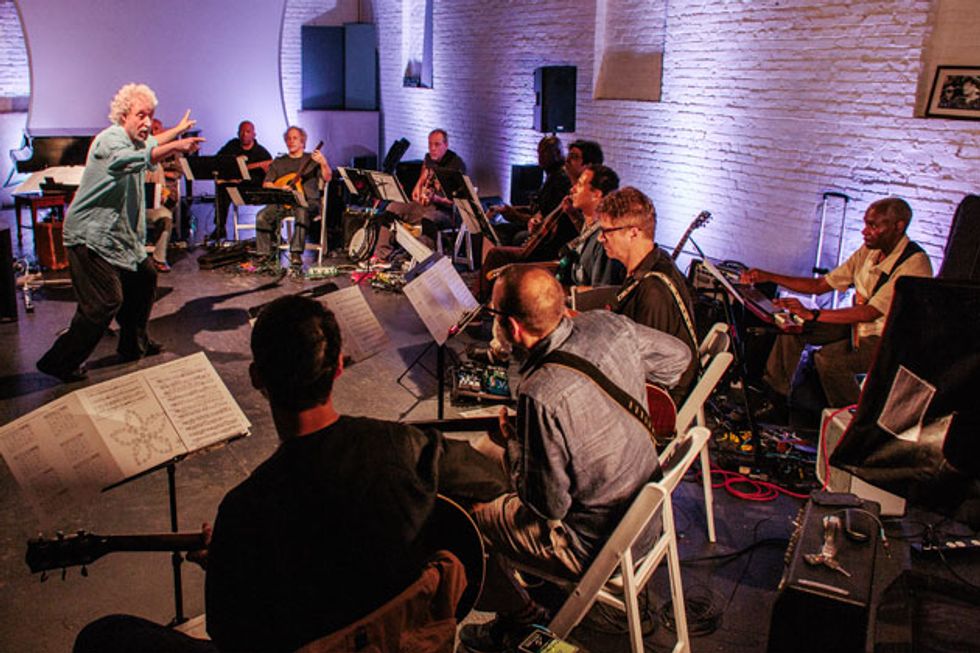

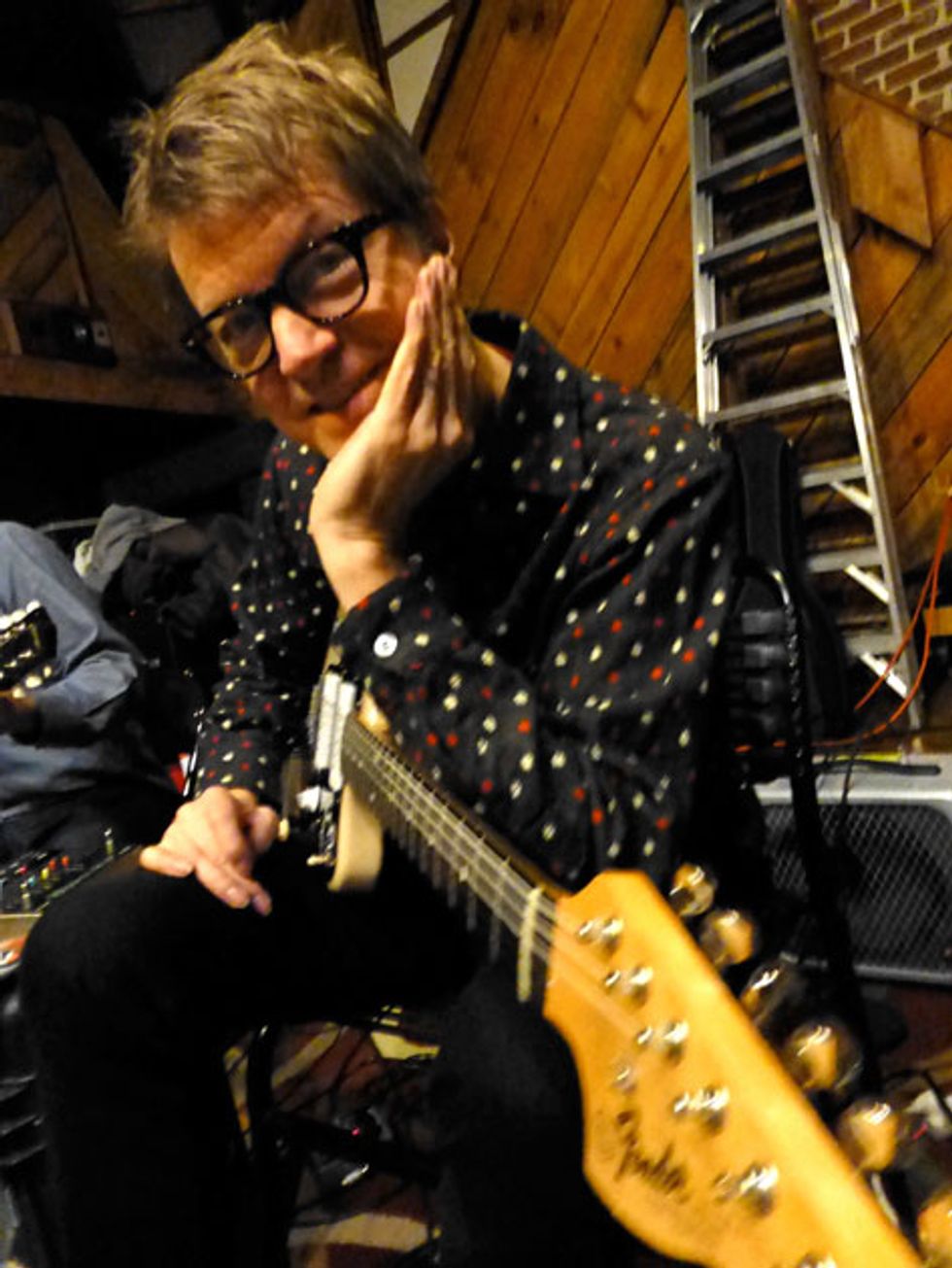
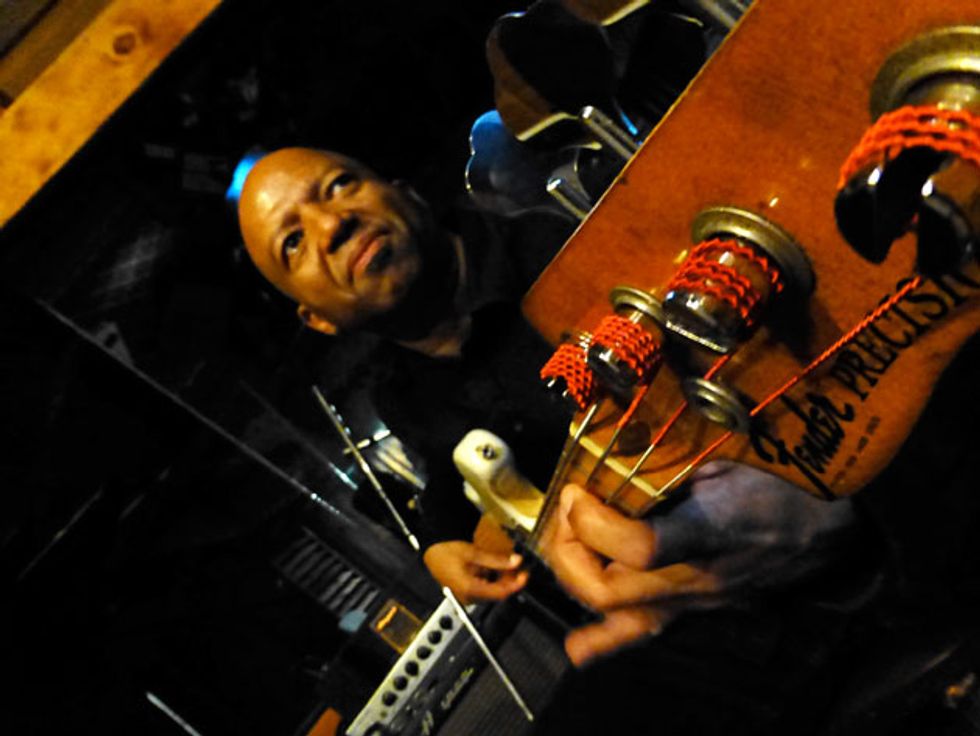

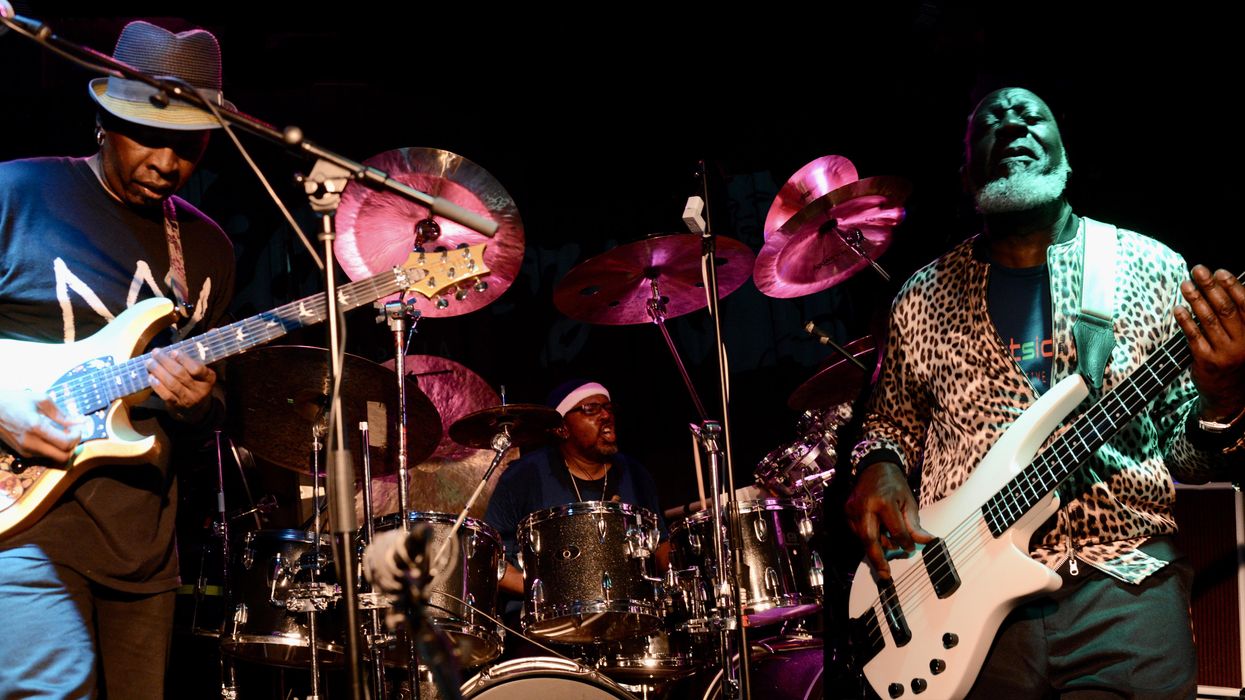
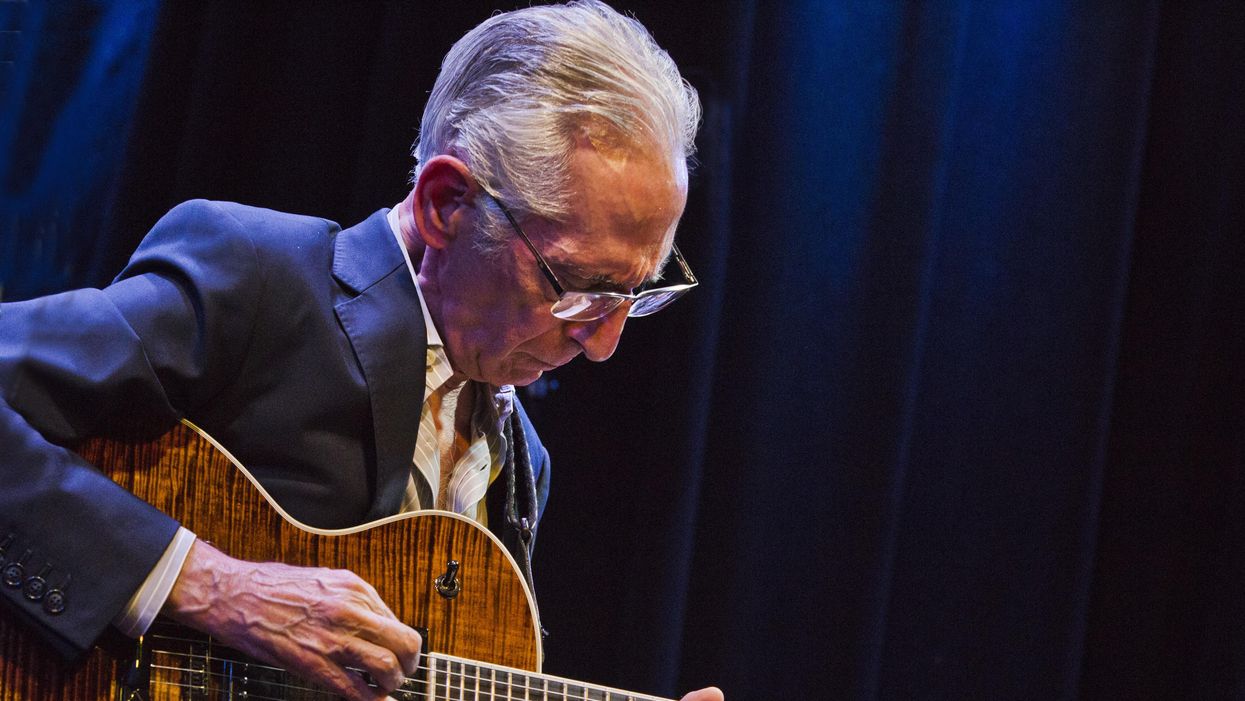


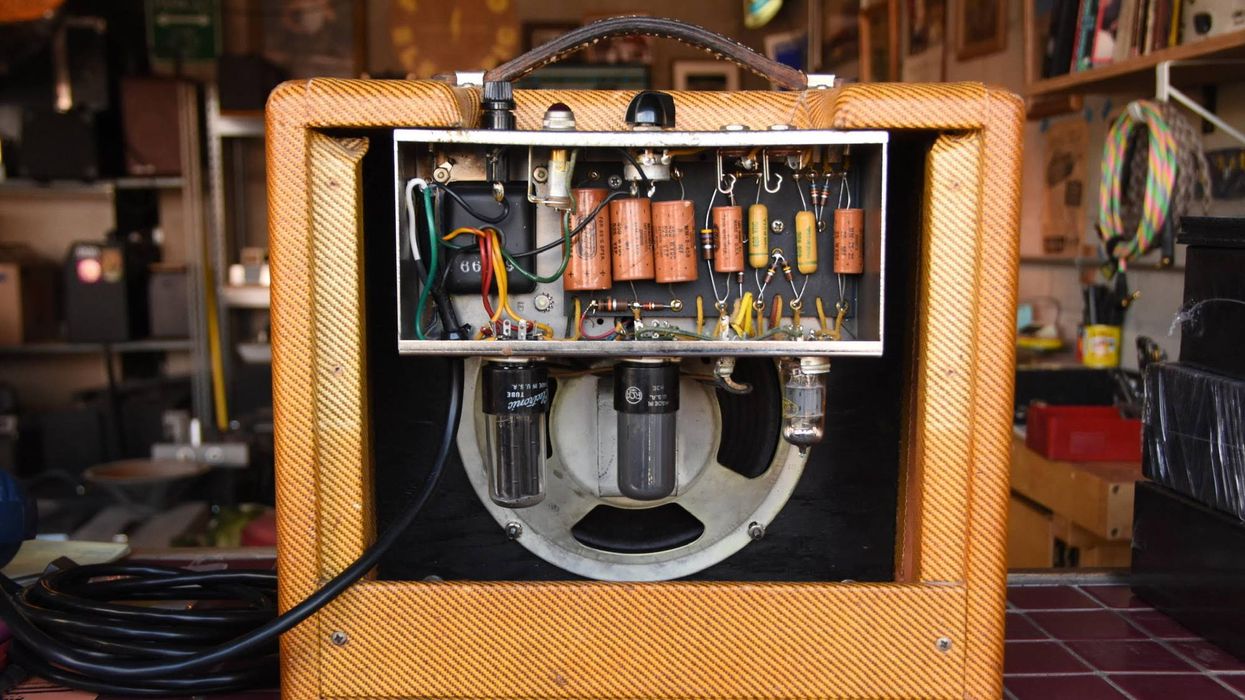

![Rig Rundown: Russian Circles’ Mike Sullivan [2025]](https://www.premierguitar.com/media-library/youtube.jpg?id=62303631&width=1245&height=700&quality=70&coordinates=0%2C0%2C0%2C0)













![Rig Rundown: AFI [2025]](https://www.premierguitar.com/media-library/youtube.jpg?id=62064741&width=1245&height=700&quality=70&coordinates=0%2C0%2C0%2C0)




















 Zach loves his Sovtek Mig 60 head, which he plays through a cab he built himself at a pipe-organ shop in Denver. Every glue joint is lined with thin leather for maximum air tightness, and it’s stocked with Celestion G12M Greenback speakers.
Zach loves his Sovtek Mig 60 head, which he plays through a cab he built himself at a pipe-organ shop in Denver. Every glue joint is lined with thin leather for maximum air tightness, and it’s stocked with Celestion G12M Greenback speakers.











